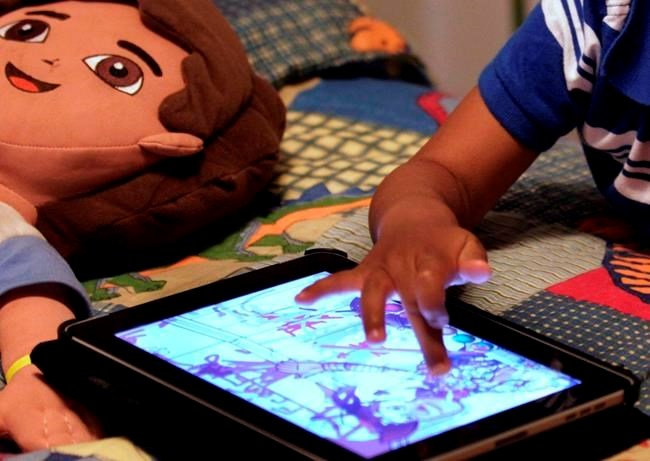TORONTO — The Canadian Paediatric Society has ditched a hard-and-fast time limit for screen use among toddlers and preschoolers, encouraging instead that parents prioritize educational, interactive and age-appropriate material.
New guidance released Thursday morning still urges no screens at all for kids younger than age two, except to video-chat with others such as grandparents, and says kids aged two to five should restrict "sedentary screen time" to one hour a day.
But a previous recommendation that set a firm cap of one hour per day for two-to-five-year-olds has been relaxed to allow for interactive and engaging forms of screen use such as educational programs and family movie nights, says Calgary pediatrician Dr. Janice Heard, a member of the group’s digital health task force.
She says parents would do better to focus on reducing passive screen use, co-viewing with kids and modelling desired behaviour.
“The best thing they can do for their child is to interact with them one-on-one, if they can,” says Heard, suspecting that pandemic lockdowns reversed pre-COVID-19 momentum to curb screen use among various age groups.
“Then they'll just naturally decrease the amount of time their children spend on screens when they recognize that it's not teaching them anything, it's not helping them in any particular way. And for the very small children, it's actually quite harmful.”
Heard says screens themselves are not inherently bad but they displace activities that are key to child development. She says excessive screen use for young kids can interfere with language development, prosocial behaviour and executive functioning.
The new guidance stresses four principles — minimizing, mitigating, mindful usage and modelling healthy use of screens.
But it’s the move away from recommended time limits that Heard hopes will encourage parents and families to actively establish boundaries to passive consumption and examine when, how and why they permit screen use for young kids.
Heard says the same principles can be extrapolated to older kids and teens, for whom the pediatric society issued similar guidance in 2019 that encouraged limits based on the individual child, without hard time cutoffs.
The pediatric society's time limits have long been a source of stress for many families unclear on what’s acceptable, says Natalie Coulter, director of the Institute for Research on Digital Literacies at York University.
"It assumes a real simplicity of ‘good time’ and ‘bad time.’ Even trying (to define) what is a screen anymore is becoming difficult,” says Coulter, an associate professor in communication and media studies.
“There's a really fuzzy line now between the real world and digital world. There's no longer a clear description. If you're going to school through a screen, is it screen time? Is it real or digital?"
Coulter is part of a research group that interviewed parents of kids aged four to 12 about screen use during the pandemic. The study includes 15 families in Canada, along with more in Australia, Colombia, South Korea, the United Kingdom, China and the United States.
Stress over how to meet screen recommendations was a common theme, she says, and the notion of imposed time limits is outdated.
“Parents are under so much pressure and so much guilt. It's kind of unrealistic and it just adds to a kind of parental sense of not being good enough," says Coulter.
"I have two girls (and) I totally struggle with it, it's not like I have these brilliant answers. But I think, like anything, as soon as you put down really hard binary rules, then it kind of shuts down dialogue a little bit."
Matthew Johnson, director of education at the Ottawa-based group MediaSmarts, acknowledges a tricky tightrope when it comes to messaging. He was involved in writing the new guidelines as a member of the pediatric society's digital health task force and notes that focusing on harms can detract from constructive advice on how to build media literacy.
"There's a risk as well that if a screen time guideline seems unrealistic, then it will simply be ignored,” says Johnson.
"It will make it seem as though if you can't reach that guideline, because it's too unrealistic, then there's nothing that you can do to manage the role of screens playing in your family. I think it's much more valuable to give parents strategies for establishing positive uses and positive relationships with screens."
The new guidance also encourages pediatricians to discuss screen use during routine visits, with Heard expressing concern that not enough families she's talked to seem to be aware of screen risks.
“I'll ask them the question: How much screen time does your child get? ‘Oh, well, probably an hour before school, a couple of hours after school, then in the evening, and they've got their TV … in their bedroom,’" she says.
“And I just think, ‘Oh, boy, we have not done a good job of educating our young parents.’”
Even small changes can have a big effect on families eager to curb screen use, she say, suggesting screen-free times of the day, screen-free areas in the home, and turning to books and crafts as alternatives.
“It's not like they have to change their entire life. But even doing one thing allows them to improve the outcomes of what is going to happen with their children,” Heard says.
“(At) the CPS we're all parents, too, we all get it. We do want to be able to give people concrete things that they can do that will make a difference that isn't going to completely disrupt their lives.”
This report by The Canadian Press was first published Nov. 24, 2022.
Cassandra Szklarski, The Canadian Press

